A webpage to accompany the Exploratorium webcast of July 9, 2004
By Paul Doherty and Eric Wegryn

Drawing of Saturn by Galileo in 1610 through a 20 power telescope. He
saw it as three planets orbiting together.
A webpage to accompany the Exploratorium webcast of July 9, 2004
By Paul Doherty and Eric Wegryn

Drawing of Saturn by Galileo in 1610 through a 20 power telescope. He
saw it as three planets orbiting together.
The first observations of the rings of Saturn were made by Galileo in 1610. He didn't know what the two blobs that he saw on either side of Saturn were. He was also surprised when they vanished two years later. When viewed from the side the rings are so thin they cannot be seen.
One early observer said that Saturn appeared to have ears.
In 1655 Christian Huygens thought that the rings
of Saturn were actually solid planar disks.
In 1659 Maxwell figured out that the disks were made of numerous
small bodies.
The rings are in the plane of
Saturn's equator.
Most of the moons of Saturn orbit in the same plane, so the view of
the rings from most moons presents a single line through Saturn,
--O--. Only the moons Iapetus and Phoebe move above and below the
rings far enough to give a good view of the rings.
The equatorial bulge of the rotating planet stabilizes the rings. Go to equatorial bulge.
Demo Spin a Koosh, If you spin a Kooshball as you throw it into the air it will assume a shape with an equatorial bulge similar to the equatorial bulge of a rotating planet.
The rings and Saturn's equator are tipped 25 degrees from Saturn's orbital plane around the sun. So from the earth we can usually see the rings except occasionally, every 15 years or so, we see the rings edge-on and they appear to vanish.
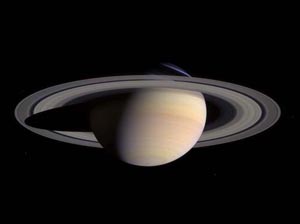
Demo Model the rings of Saturn. I used a large, 73 cm, or 32 inch, diameter fabric disk called a Beamo tm . The Beamo has a hole in the center big enough for a 12 inch diameter beach ball. I taped the beach ball into the hole. The ratio of the diameter of the beachball to the flying disk was the same as the ratio of the diameter of Saturn to the outer diameter of the bright rings, i.e. the outer edge of the A-ring. The outer edge of the A-ring is 2.3 times larger in diameter than the radius of Saturn. If this fabric ring were made to scale it would be a millionth of a meter thick, a micrometer thick, one hundred times thinner than a human hair. A 1.2 inch diameter ball is the size of the earth at this scale.
Saturn's Rings are large but very thin, they are over 280,000 km in diameter yet only tens of meters thick. Some ring particles are larger in diameter than the thickness of the rings. The rings are a million times thinner than their diameter.
Demo To appreciate the thinness of the rings picture a football field covered with tissue paper. Tip the Beachball/frisbee model to show how the rings appear edge on as Saturn orbits the sun.
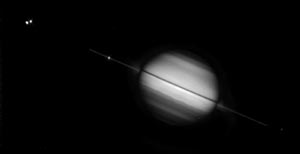
Demo The rings are made of particles that orbit Saturn in nearly circular orbits that obey Kepler's laws. A museum exhibit known as a "Gravity Well" can be used to illustrate the orbits of ring particles. Particles near the center of the well, near Saturn, orbit faster than those further from the center.
The astronomer Cassini, for whom the spacecraft is named, noted a dark band in the rings, now known as the Cassini division, which separates the outer A-ring from the inner B-ring. The rings are given letters in the order of their discovery.
Orbital Resonance
The edge of the B-ring corresponds to an orbit with a 2/1 resonance with Mimas. A ring particle at that distance orbits twice every time Mimas orbits once. The orbital disturbance grows each time as a result of resonance. Just like pushing a swing. Eventually particles are removed from the resonant gap.
Demo The gravity well can be used to show an inner orbit of a rolling marble that goes around twice for every single orbit of a rolling marble that is further from the center.
Math Root Kepler discovered that the period of an orbit, T, is related to its radius, R. By the relation
T2 = c R3 where c is a constant. Two orbits with period in a ratio of T1/T2 = 2/1 have a ratio of orbital radii of R1/R2 = (T1/T2 )2/3 = 22/3 = 1.6. So in the Gravity Well model the outer particle should orbit 1.6 times further from the center than the inner one.
The rings are richly detailed. The passage of small moons excites density waves in the rings. These are similar to spiral arms found in galaxies.
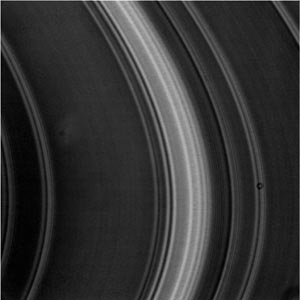
The A-ring is the home of the density waves. Moons of Saturn pull on ring particles and cause them to "bunch up" and create regions of higher and lower density. These regions get wound-up into spiral waves around Saturn. There may also be small "moons" inside the rings creating the delicate ring textures.
Demo Show a record with its spiral groove to model the finely detailed structure of Saturn's rings. Note that the record is much thicker than the rings. Sprinkle sweet-and-lo sweetener on the record to model the rings which are made of individual particles. (The record is black and becomes invisible.) Run a finger around the record to clear a path of particles and create the Cassini division. (Demo by Eric Wegryn)
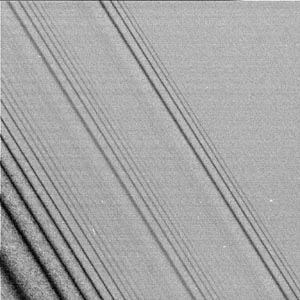
The gravitational pull of orbiting moons can also pull the particles that make-up the rings to the side making bending waves, like the corrugations in cardboard. In the following image of the A ring the waves in the lower left are density waves while the ones in the upper right are bending waves.
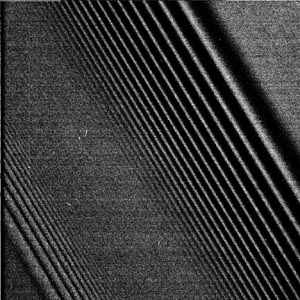
In addition to creating waves in rings, moons can also control the positions of the edges of the rings, such moons are called shepherd moons. The thin and braided F-ring has two shepherd moons, one inside and one outside of the ring
Shepherd moons
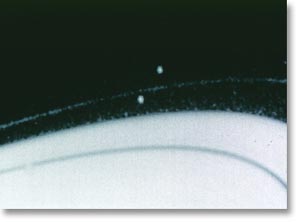
Shepherd moons flank the F-ring.
The Cassini spacecraft found that the bright rings are made of water ice, few impurities were noted. The particles range from 1 cm to 10 m in diameter, in addition, there are some larger particles up to kilometers in size and also some dust. The Cassini spacecraft did find particles in the Cassini division these darker particles were made of silicates, i.e. rock.
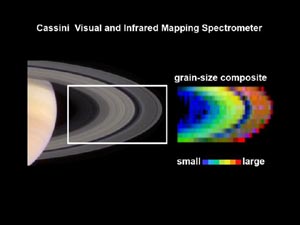
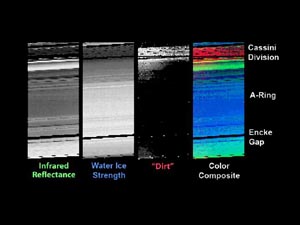
The rings are made of almost pure ice, 99% pure, but there is "dirt"
in the Cassini division.
A liquid particle will be torn apart if it within the Roche limit distance from Saturn any moon over about 100 Km in diameter behaves like a fluid, and will be torn apart within the Roche limit. Small solid particles can survive. The Roche limit for Saturn is about 2.5 times the radius of Saturn, Rs. (actually 2.456*Rs ds/dr)1/3 where ds is the density of Saturn and dr the density of the satellite. ) The bright rings are closer to Saturn than the Roche limit.
There are 3 theories of ring formation the rings are made of particles that came from:
Scientists don't know which theory is correct, if any.
Demo Tidal Forces can be modeled on the "Gravity Well" exhibit. Start two marbles touching each other near the rim of the "Gravity Well." Align the marbles along a radial line. Release them. The marbles will separate as they roll down into the well. The inner marble is closer to the center and so a stronger gravity force accelerates it toward the center. It moves toward the center faster than the outer marble leaving the outer marble behind. If the two marbles represent two rocks in space they will be pulled apart by the difference in the gravity force. This difference in the gravity force is called the tidal force. If a moon gets too close to any planet it will be pulled apart by tidal forces.
Spokes in the Rings
There are spokes in the rings which are near the synchronous orbit distance and may be due to electrostatic levitation of small particles. In reflected light the spokes are dark, in transmitted light (the right image) they are bright. This means that they are made of small particles which scatter light in the forward direction. These particles become electrically charged as they move from Saturn's shadow on the rings into daylight. Then they repel each other away from the ring plane making the spokes. They rotate at the same rate as the magnetic field of Saturn, which is a different rotation rate from that of the rings, so magnetic forces shape their motion as well as electric forces.
Demo (Flying Hydra activity) Electrostatic levitation can be done on earth too. Rub a PVC rod with wool and it becomes negatively charged. The rod can then be used to levitate a fuzzy piece of nylon which has also been charged by rubbing it with wool making it negative.
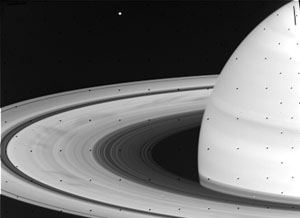
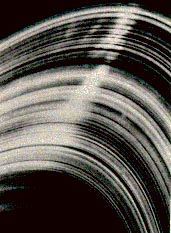
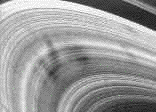
An animation showing the spokes.
|
Scientific Explorations with Paul Doherty |
|
9 July 2004 |